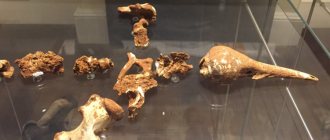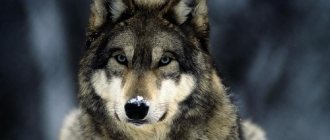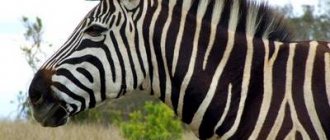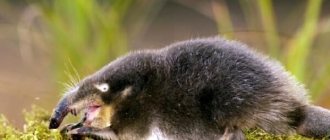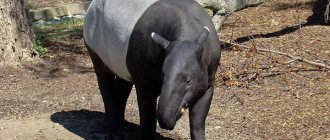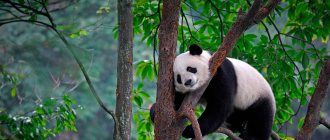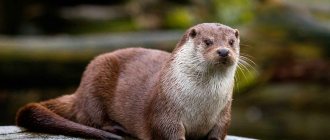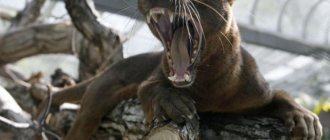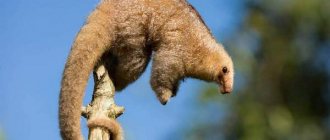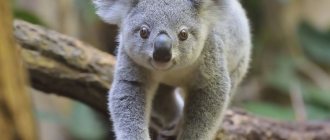Description of ermine
As was already written above, stoats are representatives of the genus Mustelidae, and in their appearance they are somewhat similar to another very popular animal - the weasel. Quite often these two animals are even confused with each other. But, despite this, after a thorough study of all the existing features of such an animal as an ermine, the description of the animal is no longer so similar to a weasel, since in fact there is a very serious difference between them.
The ermine reaches a body length of 24.5 and a tail length of 9.5 centimeters; the underparts are yellowish-white, the upperparts are brownish-red in summer, and white in winter; the tip of the tail, which exceeds the length of the head, is black throughout the year.
In all northern areas of its distribution area, the ermine wears a completely white outfit in winter, except for the always black tip of the tail, as in Germany and the Scottish Highlands.
ermine in winter photo
On the other hand, in the northern counties of England such a change of outfit occurs often, but not always; in the southern counties of the United Kingdom, the winter outfit of an ermine is very rare.
The same is true in North America: in Massachusetts, New York and Pennsylvania, animals in winter are almost always white, in Virginia, at least some wear a white outfit, and in South Carolina, the ermine always wears a summer outfit. In terms of lifestyle, the ermine is quite similar to the ferret.
For example, the size of an ermine is slightly smaller, and the tail is not as long as that of a weasel; in addition, the ermine’s fur often has a completely different shade (but the main distinguishing features of these two animals are still the size, as well as the length of their tails, since The color of their fur coat may be the same).
ermine species
Detailed characteristics of ermine:
• an ermine is a predatory animal;
• the ermine has a small, plastic and very flexible body, which can reach a length of 30 cm;
• like most representatives of mustelids, males are larger than females;
• stoats have a fairly long tail - about 11 cm;
• an adult sexually mature animal weighs 185-210 g.
It is very interesting to watch stoats in the summer, since it is at this time that the animals begin to partially change color, which is why their fur coat becomes two-colored. At this time, the ermine's head and back become brown, and the chest and belly become yellow. When winter cold sets in, the ermine's color changes again.
In cold weather, you can often meet an ermine, which has a perfectly white silky coat, and the end of its tail is painted black (by the way, it is by this difference that an ermine can be very easily recognized). Whatever the time of year, the tip of the animal’s tail never changes its color. The importance and significance of the fur of this animal is determined by its cost from clothing manufacturers and its rarity.
Birds
Due to the fact that a powerful branch of the flyway of migrating waterfowl and land birds, nesting both in the Central Russian Plain and in the north of Russia, passes through the Don River valley, the avifauna of the Rostov region is rich and diverse; it has 332 species of birds, 149 of which are nesting (breeding is expected for another 35 species).
In terms of species and quantity, the group of waterbirds prevails, confined to various aquatic and semi-aquatic biotopes, and in particular to the floodplain and delta of the Don River. This ecological group is represented primarily by waders: lapwing, lapwing, stilt, oystercatcher, curlew, godwit, waders, fifi, blackling, herbal, porpoise, common avoce, runner, etc.; and seagulls - lake, small, gray, silver, etc.; ducks are often seen - mallard, wigeon, tufted duck, teal, pintail, shoveler; geese - white-fronted, gray, lesser white-fronted, lesser bean; terns - marsh, white-winged, black; grebes - grey-cheeked, black-necked, red-necked and small; swans - whooper, mute, small; herons - gray, red, yellow, great white and little white; cranes - demoiselle, grey, white-naped crane; and etc.
The Great Spotted Woodpecker has a variegated coloration of a combination of black, white and red colors.
Despite the low forest cover of the territory, which is only 2.5%, the dendrophilous bird complex of the region is relatively rich and diverse. Pigeon-like birds are often found here: wood pigeon, clint, common and ringed doves; woodpeckers - gray-haired, green, Syrian, great spotted; day and night predators: kestrel, falcon, long-eared owl, scops owl; as well as chaffinch, oriole, greenfinch, tree pipit, great tit, blue tit, little flycatcher, etc.
58 species of rare birds are included in the Red Book of the Rostov Region: European black-throated loon, pink pelican, Dalmatian pelican, little cormorant, yellow heron, spoonbill, ibis, white stork, black stork, red-breasted goose, lesser white-fronted lesser white-fronted white-fronted lesser swan, gray duck, white-eyed duck. , white-headed duck, osprey, Common buzzard, steppe harrier, European tuvik, common buzzard, short-tailed snake eagle, pygmy eagle, steppe eagle, greater spotted eagle, lesser spotted eagle, imperial eagle, golden eagle, white-tailed eagle, griffon vulture, saker falcon, peregrine falcon, steppe kestrel, gray crane, demoiselle crane, crane, bustard, little bustard, common plover, sandpiper, stilt, avocet, oystercatcher, sandpiper, slender-billed curlew, great curlew, middle curlew, great godwit, steppe tirkushka, meadow tirkushka , black-headed gull, blackened blackbird, little tern, eagle owl, great owl, green woodpecker, common spotted woodpecker, black lark, gray shrike.
Ermine lifestyle
These beautiful, nimble and small animals live throughout almost all of Eurasia, they also live in countries such as Japan, Afghanistan, Mongolia, China, Iran, etc. And their main habitat is Greenland, the northern part of the United States (except for the Great Plains ) and Canada.
Important! Not so long ago, the residents of New Zealand wanted to breed ermines on their continent in order to significantly reduce the population of wild hares and rabbits (which settlers from Europe also brought here at one time, but by the end of the 19th century they began to cause irreparable harm to the country’s agriculture ).
But the introduction got out of the control of New Zealanders, after which stoats, in addition to rabbits and hares, began to destroy many other animals and flightless birds that nest on the ground.
The ermine does not live in Central Asia, where there are very hot deserts, or in the Arctic, where there are often severe frosts.
It is not often possible to meet an ermine during the day; at this time it usually hides, and leads an active life at night. The animal leads a very active lifestyle, its body is very flexible and plastic, and it is also an excellent swimmer and excellent at diving. This is a rather aggressive, predatory, bloodthirsty animal that has a pretty appearance and looks very cute and harmless. However, if necessary, it instantly attacks the victim, making frightening sounds (loud chirping, hissing and barking).
ermine in summer
Stoats are actually excellent swimmers, and they also move quickly and confidently through trees or other vertical or horizontal surfaces. Although, most often, their hunting takes place on the ground, because this is where most of the prey is located, in which the stoat is interested. The ermine’s lifestyle involves ownership of its own personal territory, the area of which can reach 15 hectares. Stoats regularly change their place of residence, using as their temporary home the holes of rodents or any other animals that they have killed.
When stoats go hunting, they can travel more than 15 kilometers in search of prey (if it is a period of winter frosts, then 3-4 kilometers). If an ermine escapes the pursuit of larger predatory animals, then, most often, it hides at the very tops of the trees and sits there until the predator gives up and leaves.
One of the main distinguishing features of these animals from the Kharkov family is that stoats cannot live in captivity. If they are confined to a cage or enclosure for a long time, the animals stop reproducing and die quite quickly.
Let's draw a mink - lesson 1
I choose a photo of a mink on the Internet and draw a sketch with a pencil.
Without a sketch, comrades, it’s like being in a foreign city without a map. Always start with a sketch. No cute face or beautiful fur will help if you don’t have a design for the drawing as a whole.
This mink is American; it has a uniform body color and a small white spot on the lower lip. In the selected photo, the animal’s paws (already short) are barely visible. But they are there, and I will build a diagram of their bending - just to be honest about the matter.
Now you can draw in parts. First, the long body and tail:
The legs are short. There are swimming membranes between the fingers, but this is just a theory; they cannot be depicted in our drawing.
The muzzle is wide, slightly flattened.
The ears are round, small and barely noticeable:
And here is Mink’s first drawing, also known as “Mink’s coloring book”:
I won't paint, I'll only show the shadows
Do you remember about the systematically important white spot on the lip?
Let's delve into the topic and draw another coloring picture.
Stoat habitat
Often, the choice of a permanent place of residence by an ermine is influenced by various factors: temperature conditions, the number of rodents in the area, the presence of nearby vegetation and bodies of water (rivers and lakes), etc.
It is almost impossible to meet this animal in forest thickets, although some individuals can sometimes settle there in ravines or spruce forests. For living, the ermine most likes the edges of the forest or those areas where deforestation has been carried out, however, at the same time, such areas should be hidden as much as possible. Considering that the ermine is not particularly afraid of direct contact with humans (although it avoids them), quite often it can settle in fields, as well as gardens, which are closely adjacent to some populated areas.
After the onset of high water, the stoat migrates to its previous places of residence. The animal most often waits out winter frosts by settling in close proximity to small towns or villages, since at this time there is a maximum concentration of various rodents here. Very often, during this period, rural residents can find an ermine in their hayloft, in a pile of firewood, logs, stones or in the stump of an old tree.
If we talk more specifically about where the ermine lives, then we can safely say that it does not have any special requirements for housing. Most often, stoats use burrows or other shelters that have already been dug by someone. Interesting information! Male and female stoats do not live together throughout the year, and they meet only during sexual activity.
Lifestyle
The ermine leads a solitary lifestyle and meets with other ermines only during the mating season for reproduction and procreation. An exception is also a female with a litter of cubs.
Typically, each ermine has its own territory, the size of which can be up to 20 hectares. The animal marks the boundaries of its territory with its excrement and really does not like it when some other stoat violates them. When there is little food, the stoat can leave its territory and even move long distances in search of more “grainful” places.
The stoat is a nocturnal animal; its period of activity begins at dusk and continues at night; it is at this time that stoats hunt for food. During the day, he sleeps in his hiding places, to which he is very unpretentious. Ermine hideouts can be in the most unexpected places: hollows of old trees, in a haystack, or in a pile of stones. Sometimes stoats occupy the burrows of rodents they kill.
Hunting ermine
Thanks to his still respectable height, he can handle fairly strong animals such as hares, rabbits and poultry, and pursues them mercilessly. He dares to attack even very large hares, and in a poultry house he can strangle over 40 adult chickens in one night. Stoats usually hunt in pairs, sometimes up to three or more animals gather for a common cause.
It goes out for prey both during the day and at night, climbs quite well, swims excellently and does not hesitate to go into the water if necessary. The ermine's favorite habitats are dense thickets and rocky places, which provide it with reliable shelter from enemies.
When in danger, it also emits a highly unpleasant, piercing odor for its protection.
stoat hunts
In order to kill its prey, the stoat makes several bites to the back of the head. If he sees that the victim does not stop showing signs of life, the bites are repeated until the victim dies. The animal tracks fish using its keen vision, searches for rodents using its sense of smell, and manages to catch insects thanks to the sound they make. If this animal finds itself in very difficult circumstances (most often during the winter cold), it may begin to steal frozen meat or fish from people.
If we talk more specifically about what the stoat eats, then the main part of its diet is shrews, voles, hamsters, muskrats, chipmunks, etc. During the hungry months, these animals often change their “traditional” diet to one in which most of the diet is consists of various kinds of insects, bird eggs, lizards, fish, frogs (insects and lizards are hunted extremely rarely).
stoat with prey
The ermine can also hunt hazel grouse, partridges, rabbits, hares and wood grouse (those animals that are much larger than the ermine itself). And this, by the way, is another serious difference between this animal and the weasel. The ermine is the only representative of the mustelid genus that manages to successfully hunt animals several times its size. Most of these animals have already been listed above, but this list can also include lemmings, water voles, etc. If, thanks to a successful hunt, an animal has an excess of food, it puts it aside.
Nutrition
What does an ermine eat? The ermine, although small, is a very agile predator. The main diet of stoats are various small mouse-like rodents: mice, rats, hamsters, voles, chipmunks, famous for their migrations
Lemmings. The migration time of lemmings is especially beneficial for stoats (as well as many other predators that feed on lemmings) - “food” in large quantities “goes into your hands.”
In addition to rodents, stoats are not averse to feasting on small birds (partridges, wood grouse, hazel grouse), as well as their eggs, large insects,
lizards and snakes, as well as rabbits and hares, which in size sometimes exceed a small hunter.
Well-developed sense organs help stoats hunt: good vision, hearing and smell, as well as a quick reaction. They wait for their prey in ambush, then make a swift dash, grab it with their teeth and bite the back of the head. They usually hunt at night or in the evening.
Also, some stoats (especially females), taking advantage of their small size, engage in burrow hunting - they climb into the holes of rodents and kill them there.
Although the ermine, due to its small size, does not pose any danger to humans, the ermine is very, very dangerous for its victims. Sometimes he even hypnotizes his victim, performing a special dance called the “ermine dance of death.” This dance is designed to distract the attention of the prey and get closer to jump.
Ermine reproduction and lifespan
Both male and female stoats have several partners during their lives, as they are polygamous animals, breeding once a year. The sexual activity of these animals lasts from the end of winter to the beginning of summer (this period lasts for 4 months - from the 20th of February to June).
Pregnancy in a female ermine lasts about 9-10 months. The embryo may stop developing until the onset of warm weather, and in late April - early May, ermine cubs begin to be born (about 12 months after their conception).
Ermine with baby
Only the female raises and feeds the babies, and she is capable of giving birth to 5-12 cubs at a time (in rare cases, 15). Immediately after birth, the weight of small stoats is no more than 4 grams. They are born blind, deaf and without teeth; their eyes begin to open only after 30-40 days. And after 90-100 days, babies are almost impossible to distinguish from adult stoats. Around the end of July, they begin to independently obtain food.
In females, maturation occurs very quickly - maximum in the 4th month, but in males this process lasts much longer - they reach maturity only 10-12 months after birth. Adult males who have reached maturity can quite often mate with a female who is no more than 2 months old.
If we talk about how long an ermine lives, then the maximum age of both females and males can reach 7 years (on average they live up to 4 years).
In April and May, in a nest located in some hole, 5, sometimes 6 cubs are usually found, the number of which can vary, however, from 2 to 12. In the past, ermine fur was, as is known, very highly valued. However, not all furs are equally good; the best are those that come from northern areas; in the south, the hair is shorter and thinner, and the color never reaches such whiteness as in the north.
An ermine is a small fur-bearing animal belonging to the mustelidae family. The animals belonging to this family have become very popular because of their charming appearance and the different stories that people once came up with, and after a while they turned into beautiful legends.
In former times, people believed that when an ermine's fur coat got dirty, it would soon die. For this reason, they made every effort to protect these animals. In that ancient time, precious ermine fur was used to sew robes, headdresses and, of course, was one of the most luxurious decorations for dresses.
Mention of this beautiful animal is often found in ancient art, where the ermine personifies nobility and impeccability. At one time, even Leonardo da Vinci, having painted the famous painting “Lady with an Ermine,” brought to the fore all the grace and artistry of Cecilia Galleroni, who had a rather cool disposition and was very well-read.
And even in our time, many people are confident that the ermine embodies high morality and nobility.
Keeping at home
Sometimes some lovers of unusual pets are not averse to getting a pet ermine. It is important to note that an ermine living in the forest will never become tame and domesticated. There is only one way to tame this animal - from birth, feed it from a bottle with your own hands. Then the ermine will regard the person feeding it as its mother. And yet he will become tame and domestic, you can even go for a walk with him, holding him in your arms.
The ermine should be kept in a special cage and released into the wild for 2-3 hours, always under watchful supervision. Being very fast and nimble, an ermine can easily escape into any, even small, crack or doorway. Also, do not forget that the ermine is a nocturnal animal, so you should be prepared for sleepless nights and also a nocturnal lifestyle if you have such a pet.
Particular attention should be paid to the nutrition of the domestic ermine. What to feed an ermine at home? Of course, raw meat, because it is a predator. Raw chicken, turkey, goose, and any poultry in general will work great. They can also be fed rabbit meat. But it is better not to feed stoats beef or pork, this meat is not typical for these animals. If you manage to catch live mice or
frogs, then they can be an excellent treat for this pet. On average, an ermine should eat half its body weight in meat. And once a week you can do a fasting day. Ideally, it would be to have a special aquarium with feeding mice for the stoat.
It is important that there is a drinking bowl in the cage and constant access to drinking water, which is also necessary for the ermine. The cage itself should be moderately spacious and at the same time tightened with wire with small cells. Its floor should be covered with sawdust and driftwood. The cage must be equipped with a good lock - stoats are very smart creatures and can open a bad lock and get out of the cage, then finding them will become very difficult.
Stoats are clean animals, so it is relatively easy to train them to relieve themselves in a special tray. Once they have done this, they will continue to relieve themselves there, guided by the smell. But remember that the cage must be cleaned periodically, and male stoats during the mating season can emit an additional very unpleasant odor (to avoid this, they can be castrated). In a word, if all these difficulties and troubles do not scare you away, then you can get yourself a pet ermine.
Why is ermine valuable to humans?
It cannot be said that the stoat is a harmless animal. At the moment when this animal feels the greatest danger, even from a person, it can attack and cause quite serious injuries (severely bite or scratch). Although stoats try not to come into direct contact with a person and hide before he appears.
Due to the fact that these animals have been actively hunted recently, the quality of their diet is getting worse and there is constantly less of it, and shelters are being destroyed, the stoat population has decreased significantly. But the main reason for this reduction, of course, is hunting, and this happens especially actively in winter, since in winter ermine fur becomes very attractive and it is very highly valued.
Since ancient times, people have sewed hats, fur coats and other warm clothes from ermine fur, which had an extremely negative impact on the number of these animals. However, clothes made from ermine are short-lived, since the fur coat of these animals is most afraid of friction. But still, clothes made from ermine are incredibly expensive, so only fairly rich people can buy them.
The benefits of these small predatory animals are undeniable - they destroy rodent pests, sick animals, etc.
In some countries it is prohibited to hunt stoats, as they have long been listed in the Red Book.
Interesting Facts
- An interesting historical legend is associated with ermines. It was in the Middle Ages, being pursued by his Norman enemies, the Duke of Brittany Alain, nicknamed “Crooked Beard,” with the remnants of his army, was stopped by a flooded river, dirty and muddy. In front of the river, the Duke saw an ermine, also running away from galloping horses and also stopped by the river. The ermine turned sharply at the very water, preferring to die rather than be smeared in mud. This behavior of the animal inspired the Duke so much that he immediately shouted to his people “better death than shame!” The inspired Bretons gave battle to the Normans and won, and from then on the ermine began to adorn the coat of arms of the Dukes of Brittany, as a symbol of courage and bravery.
- Since ancient times, ermine fur served as decoration for royal robes and hats.
Appearance
The ermine is a small animal with a long body and short legs. The animal's neck is long and its ears are round. The head resembles a triangular shape. The male's body is about 16-40 cm in length. Females are generally half as long. The tail occupies approximately 35% of the total body length and its length is about 5-13 cm. The weight of stoats ranges from 70 to 270 grams.
The color of the ermine depends on the time of year: in winter the color is white, and in summer it consists of two colors: brownish-red and yellowish-white. The tip of the tail is black, regardless of the time of year.
Ermine in winter.
An ermine in winter color, a black spot on the tail is visible.
Ermine in summer.
Hybrids with other mustelids
Work was carried out on the hybridization of the ermine with the common and Central Asian weasels, with the solong (both direct and reciprocal crossings were carried out). However, despite the fact that the females were in pronounced estrus (heat) at the time the males were added to them, no coverings were observed, moreover, several deaths were recorded. This is how a male Central Asian weasel killed a female ermine. Perhaps in the future some of these crosses, with repeated attempts and improvement of the technique, will turn out to be more successful.
Reciprocal crosses are two crosses characterized by directly opposite combinations of sexes. For example, a female ermine and a male of another species, as well as a female of another species and a male ermine.
Photo credit: Andrew, CC BY 2.0
Bibliography
- Animals and plants. Illustrated encyclopedic dictionary. - M.: Eksmo, 2007. - 1248 p.: ill.
- Zenkevich L.A. Life of animals. Mammals or Beasts. Volume 6, publishing house "Enlightenment", Moscow, 1971.
- Zaitsev V.A. Vertebrates of the northeast of the Central region of Russia. (Types of fauna, numbers and changes). M.: T-vo scientific publications KMK. 2006. 513 p. +8 colors Pasted in.
- Ivanter E.V. Mammals of Karelia. - Petrozavodsk: PetrGu Publishing House, 2008. - 296 p. (Popular monographs on ecology).
- Ivanter E.V. Teriology: textbook. - Petrozavodsk: PetrGu Publishing House, 2014. -703 p.
- Pavlinov I.Ya., Kruskop S.V., Varshavsky A.A., Borisenko A.V. Land animals of Russia. Reference guide. M.: KMK publishing house, 2002. 298 p. 253 ill. 249 cards. Bible 30.
- Sidorovich V.E. Mink, otter, weasel and other mustelids. Minsk: Urajai, 1995. 191 p.
- Sobansky G.G. Game animals of the Altai Mountains. Novosibirsk: Science. Sib. Department. 1988. - 160 p. ill. — (Man and the environment).
- Smirin V.M. Portraits of animals of Northern Eurasia. Predatory: Science and art for environmental education / Concept and general editing by A.i. Oleksenko, A.V. Zimenko; comp. Toma A.I. Oleksenko (director of the book), A.V. Zimenko, E.V. Zubachininova. — M.: Publishing house of the Center for Wildlife Conservation. 2011. - 416 p., ill.
- Ternovsky D.V., Ternovskaya Yu.G. Ecology of martens. Novosibirsk: VO "Science". Siberian Publishing Company, 1994. - 223 p.
- https://www.catalogueoflife.org
- https://www.dikiezveri.com/gornostaj1.html
- https://www.iucnredlist.org/species/29674/45203335
- https://piterhunt.ru/pages/animals/anim/hishniki/kuni/gornostay/1.htm
- https://xn--80adjapb7awdo4m.xn--p1ai/blog/obzor/domashniy_gornostay/
- https://xn——6kcbac1azfofe4cmqhvgl0bzre.xn--p1ai/stati/flora-i-fauna/gornostai.html
- https://zooclub.ru/tree/mustela_erminea
Author of the article: Dmitrieva Oksana Alekseevna, zoologist
Did you like the article? Share with your friends:
Population status
The stoat population has recently begun to replenish itself, in part because demand for products from these animals has decreased. Although 10-20 years ago the population was on the verge of extinction.
Ermine.
Ermine.
Ermine: photo of the face.
Ermine: photo.
Ermine: photo on a stone.
Ermine: photo of the face.
The photo below was included in The Guardian's list of the best wildlife photos of last year.
Ermine in spring, North Yorkshire, England.
Source
